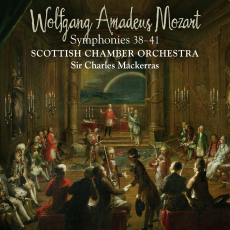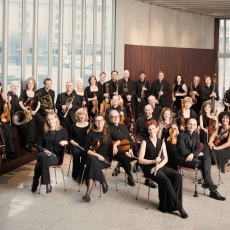Mozart Symphonies - SCO & Sir Charles Mackerras - The Berkshire Review
Now is as good a time as any to survey recent performances of Mozart's symphonies, since Linn Records' Mozart Symphonies 38 - 41 by the Scottish Chamber Orchestra and Sir Charles Mackerras has just won the Critics Award of Classical BRIT. Sir Charles' earlier cycle of Mozart symphonies with the Prague Chamber Orchestra on Telarc won numerous prizes and remained at the top of many critics' shortlists for many years. Now he has returned to the last four symphonies: the "Prague," K. 504, K. 543, K. 550, and K. 551, the "Jupiter," with the incomparable Scottish Chamber Orchestra and Linn's incomparable recording technique. (Good news! This summer Sir Charles and the SCO will record five earlier symphonies, K. 201, K. 297, "Paris," K. 318, K. 385, "Haffner," and K. 425, "Linz.") When Sir Charles, who is now 84, approaches a cycle of concerts or recordings, he usually has some new concept in mind behind the project, so that his approach not only has an innovative premise, it is musically fresh as well. He never repeats himself.
It looks as if Sir Charles' Mozart Symphonies will fill the same authoritative position as his Prague cycle from the mid-1980's on Telarc, which, like Linn, began as an audiophile label. Digital recording, of course, was still in its dark ages in 1986, but Telarc certainly offered close to the best available at the time. Linn, on the other hand, represents the state of the recording art in the present. While only a few bars will show the shortcomings of digital technology during its first decade, Telarc set the Prague Chamber Orchestra well back in an attractively reverberant space. Their playing is also first rate, incisively phrased and wonderfully expressive in broad lyrical phrases, but not quite a match for the SCO. As much as I like the the old Prague set-and I am certainly not about to give the one disc I have from it away-the Linn release is the one to have. While the early set aimed at an almost romantic spaciousness, the new one strives for presence and intimacy, and there is a reason for this. As Neal Zaslaw observes in his lively notes, concert venues in Mozart's Vienna were small. Orchestras were small. And this was especially true in 1788, when Mozart wrote his three last symphonies. An ill-conceived war against the Turks depopulated Vienna of her aristocrats, who were in a position to enjoy and pay for Mozart's symphonies, sending them either into battle or off to their country estates. Zaslaw points out that the audiences sat close to the musicians, and, at private concerts, even among them, to observe or to play along on their own instruments. This is the sort of experience Linn's producer, veteran James Mallinson and engineer Philip Hobbs were attempting to recreate in the recording. Another significant difference is that the SCO are playing period instruments. In their regular concert schedule they switch back and forth and are equally comfortable with historical instruments or modern.
The booklet also contains a brief note by Sir Charles himself, in which he focuses on tone color, harmonic progressions, and on particular details which make each symphony unique, for example the "almost Schoenbergian tone row" in the development of the finale of the G Minor. In this case there is not quite the mass of information as there was behind his ground-breaking and essential recordings of Brahms' symphonies in the style of their early performances with the Meiningen Orchestra, but his observations are as enlightening as the performances themselves. It is difficult to convey this wonderful achievement without describing it bar by bar, phrase by phrase, but these notes will have to suffice.
The elaborate slow introduction to the "Prague" Symphony opens with solemn chords, glowing with the brilliant, biting sound of valveless period trumpets, and proceeds broadly, as its affectingly phrased lyric lines unfold before us. When the nervous, syncopated accompaniment to the first subject appears, we immediately focus on the quiet but toothy attacks of the gut strings articulating the repeated notes of the theme. There is not only an impressive dynamic range, but a great variety of color and spatial relationships in the intimate sounds of the reduced string band, as they interact with winds, brass, and tympani. Tutti have a muscular core of brass. The contrapuntal development is crystal clear, and we have a full sense of the interplay of the musicians. Sir Charles balances the orchestral voices most carefully to bring out the color and meaning of Mozart's harmonic progressions. The harmonic miracle in the recapitulation is breathtaking. The wistful phrases that we are more accustomed to hearing as rather fuzzy gestures of strings and winds jump forward as nuanced dialogues among the orchestral choirs: soft attacks, sharp attacks, feminine cadences, Sir Charles renders every nuance to a kind of perfection. All the color, expressiveness, and nuance of Sir Charles' highly developed understanding of Mozartian style on period instruments make for a major step forward in our understanding of the symphonies.
The E flat begins with magnificently balanced chords and resonant drum rolls leading into a double-dotted meter, redolent of the eighteenth century. The impeccable intonation of the SCO's first violins provides just what is needed as Mozart searches with tentative inspiration for his home key. The first subject gets the exposition off to an athletic start, which never compromises the expansive, dreamy theme which follows. Sir Charles moves into the coda with a thrillingly energetic and sweeping cadence worthy of Furtwängler. The slow movement is both pensive and yearning; it has both breadth and nerve, which comes to the fore in the agitated second section. The eloquent playing of the SCO lower strings and winds on their period instruments is invaluable here, not to mention in the clarinet duo of the trio. Sir Charles' athleticism continues through the minuet to the crisply articulated finale, where the balance of upper and lower strings, throaty valveless horns in the middle, and the observation of all the repeats give the movement the necessary ballast to keep it from flying off into the aether like an exuberant salamander.
In the first movement of the G Minor the marvelous variegation of string color, only possible with gut-stringed instruments in hands as capable as the SCO's, are a marvel in both the first and second movements. As in the others, this slow movement is a marvel of lyrical inwardness and alert precision, resplendent with a vast range of subtle timbres. The minuet is rapid and bracing, tempered by an ardent yearning in the trio. (Sir Charles' ready access to these unsettled youthful moods is a particularly interesting feature of the entire series.) The SCO's precision, which often strikes me as the fulfillment of what Szell attempted to achieve somewhat too purposefully with the Cleveland Orchestra, is matchless. The final chord, with its ghost of a resonance in the celli, hinting perhaps of a resigned final breath, is one more epiphany in this adventure.
Inevitably the textures of opening movement of the "Jupiter" are more massive, and the gait is broader. Sir Charles also strives for breadth and the long line in the slow movement. As his program notes suggest, he does wonders with the color gamut of the muted strings, which are rare in Mozart's works, not to mention their particular color against bassoons, flutes, and horns towards the conclusion. The minuet has a flowing, Ländler-like swing to it. After a broad statement of the the main theme in first violins, the great finale erupts, almost, in a burst of contrapuntal energy, settling into a steady, but urgent pace, over which we can hear the details of Mozart's amazing writing, as well as to allow the grand wisps of melody to breeze over the pedal points below them. The litheness and clarity of the double-basses also make a difference here. Brass are ready at hand to add a jubilant accent, especially at the end of phrases and sections. The grandeur of the final fugal section and coda is consummate. So ends the first instalment of the greatest interpretation of the Mozart symphonies of our moment, one in which the scholarship and craft of historical interpretation lead to a real extension of our understanding of these essential works.
To read the full review click here.

